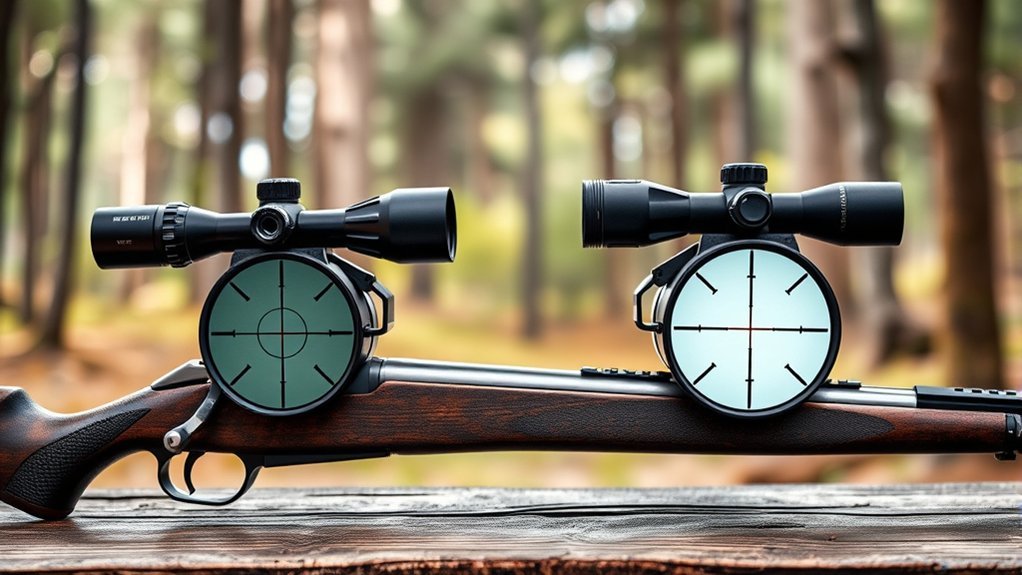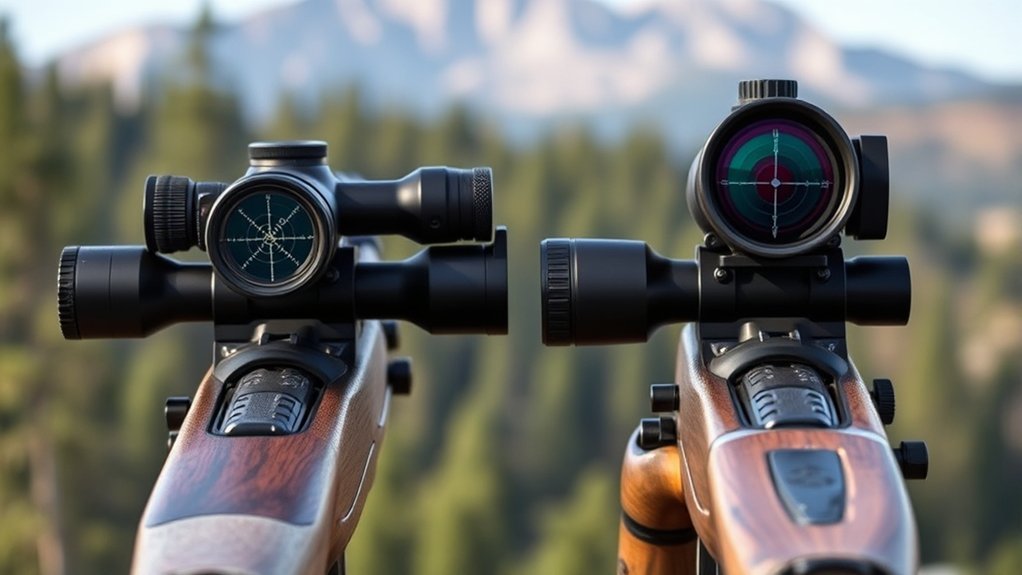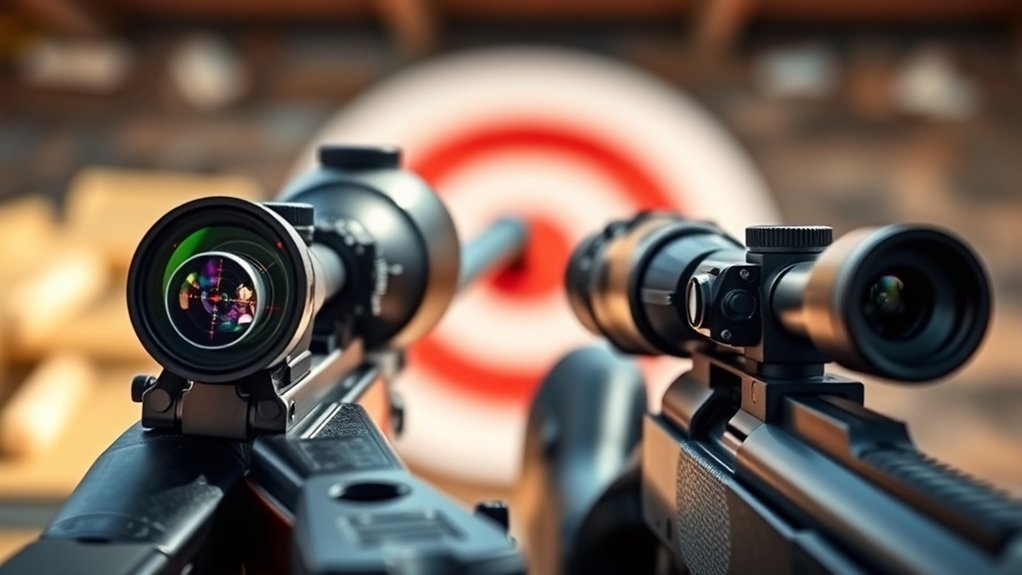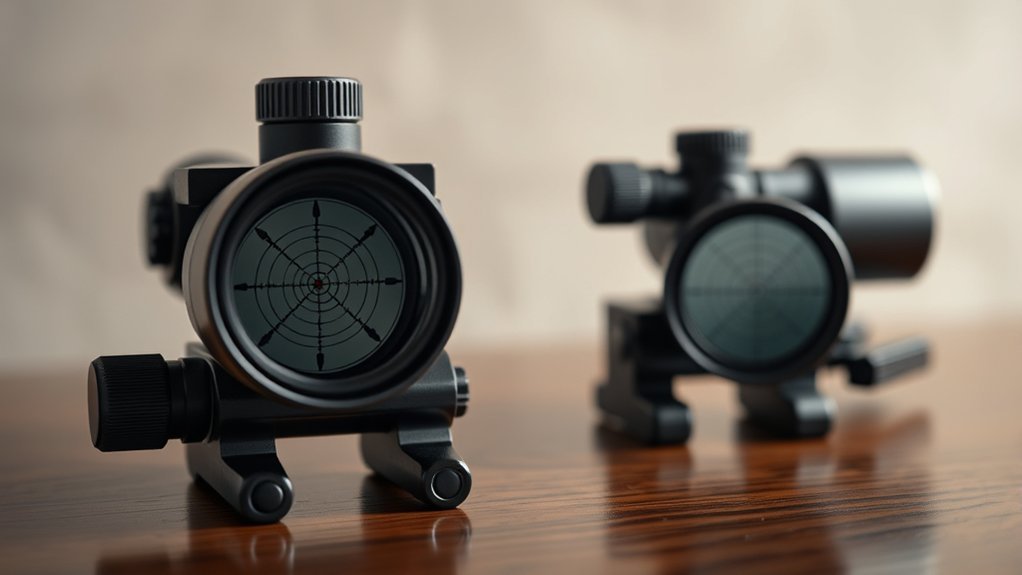When choosing a scope, the focal plane can greatly impact your shooting experience. First focal plane (FFP) scopes adjust the reticle size with magnification, while second focal plane (SFP) scopes keep it constant, affecting subtension accuracy. Understanding these differences can help you make an informed decision. But which option aligns best with your shooting style and needs? The answer might surprise you.
Understanding Focal Plane Scopes

Focal plane scopes are fundamental tools for precision shooting, and understanding their mechanics can greatly enhance your shooting experience. These scopes feature reticles positioned at specific points within the optical system, affecting how they interact with magnification. In a first focal plane scope, the reticle scales with magnification, allowing for accurate range estimation at any zoom level. Conversely, second focal plane scopes maintain a constant reticle size, which can lead to inaccuracies in ranging at higher magnifications. Knowing these differences is essential for selecting the right scope for your shooting style. You’ll find that mastering these mechanics not only improves your accuracy but also boosts your confidence during critical shooting scenarios, making it a crucial aspect of your equipment knowledge.
What Is a First Focal Plane Scope?

A first focal plane (FFP) scope places the reticle within the optical system in such a way that it scales with the magnification level. This means that as you adjust the zoom, the size of the reticle changes proportionally, maintaining its relative size to the target. You’ll find this feature particularly useful for ranging and holdover calculations, as the reticle’s subtensions remain accurate at any magnification. FFP scopes usually feature mil-dot or hashmark reticles that help you estimate distance and bullet drop effectively. They’re favored in long-range shooting, as they allow for precise aiming at varying distances without needing to switch magnification levels. Understanding this design can enhance your shooting experience considerably.
Advantages of First Focal Plane Scopes

One of the primary advantages of first focal plane scopes is their ability to maintain accurate reticle subtensions at any magnification level. This means that whether you’re zoomed in or out, your holdover points and windage corrections remain consistent, allowing for precise shot placement. With the reticle scaling with magnification, you can make quick adjustments without needing to calculate or remember changes in subtension. This feature is particularly beneficial in dynamic shooting situations where conditions may change rapidly. Additionally, first focal plane scopes often offer more flexibility for ranging targets, as you can accurately measure distances at any power setting. Overall, these scopes enhance your shooting experience, providing greater confidence and effectiveness in various scenarios.
Disadvantages of First Focal Plane Scopes
First focal plane scopes come with notable disadvantages, primarily their higher cost compared to second focal plane options. Additionally, their complexity in usage can be challenging, especially for those unfamiliar with adjusting reticles at varying magnifications. These factors can deter some shooters from choosing first focal plane scopes for their needs.
Higher Cost Factor
While many hunters and precision shooters appreciate the benefits of first focal plane (FFP) scopes, the higher cost factor can be a considerable drawback. FFP scopes generally come with advanced features, such as precise reticle adjustments and superior glass quality, driving up their price. You’ll often find that these scopes can cost considerably more than their second focal plane counterparts, which may be more appealing for budget-conscious shooters. Additionally, the manufacturing process for FFP scopes is typically more complex, contributing to their elevated cost. If you’re looking to invest in a reliable optics system, you’ll need to weigh these expenses against the performance benefits to determine if the higher investment is worth it for your specific shooting needs.
Complexity in Usage
Investing in a first focal plane (FFP) scope can bring advanced features, but it also introduces complexity in usage that may not suit every shooter. The reticle’s size changes with magnification, which can be both an advantage and a challenge. You might find it difficult to quickly adjust to the varying subtensions, especially in high-pressure situations.
| Pros | Cons |
|---|---|
| Precision at all magnifications | Steeper learning curve |
| Better for ranging targets | Potential for distraction |
| Enhanced versatility | Requires practice for mastery |
Ultimately, while FFP scopes offer benefits, their complexity may overwhelm casual shooters, making second focal plane options more appealing for simplicity and ease of use.
What Is a Second Focal Plane Scope?
A second focal plane (SFP) scope is designed so that the reticle’s size remains constant regardless of the magnification level. This means when you zoom in or out, the crosshairs won’t change in size, providing a consistent aiming point. SFP scopes are particularly beneficial for precision shooting at varying distances, as they allow for an uncluttered view of the target. Since the reticle doesn’t expand with magnification, it can be easier to focus on smaller targets without distraction. However, you must remember that the subtensions marked on the reticle are only accurate at the highest magnification setting. This design choice can influence how you approach holdovers and windage adjustments while shooting.
Advantages of Second Focal Plane Scopes
One key advantage of second focal plane scopes is their ability to maintain a consistent reticle size, which aids in target acquisition and precision shooting. This stability allows you to easily estimate distances and holdovers at various magnifications without worrying about the reticle changing size. Here are three more advantages you should consider:
- Simplified Rangefinding: The reticle remains constant, making it easier to use for quick range estimations.
- Less Parallax Error: Since the reticle doesn’t adjust with magnification, parallax errors are minimized at specific distances.
- Optimized for Hunting: These scopes often provide a clearer sight picture at lower magnifications, which is beneficial in dynamic hunting scenarios.
Disadvantages of Second Focal Plane Scopes
While second focal plane scopes offer certain advantages, they come with notable disadvantages. You might find that their limited range accuracy can affect performance at varying distances, making precise adjustments more challenging. Additionally, the complex reticle scaling can be confusing, especially during rapid engagements or long-range shots.
Limited Range Accuracy
When considering limited range accuracy, second focal plane (SFP) scopes can present significant challenges. Unlike first focal plane scopes, SFP scopes maintain a constant reticle size regardless of magnification. This can lead to issues when engaging targets at varying distances. Here are three key limitations:
- Holdover Calculations: At higher magnifications, the reticle may not correspond accurately to bullet drop, complicating holdover shots.
- Target Acquisition: The fixed reticle size can make it harder to quickly acquire targets at different ranges, especially in dynamic situations.
- Precision at Long Range: You might struggle to make precise adjustments for windage and elevation, resulting in less effective long-range shooting.
These factors can hinder your performance, especially when precision is paramount.
Complex Reticle Scaling
Limited range accuracy isn’t the only concern with second focal plane (SFP) scopes; complex reticle scaling can also hinder your shooting experience. In SFP scopes, the reticle remains the same size regardless of magnification, complicating your ability to use holdovers and subtensions. As you change magnification, your target’s dimensions can appear inconsistent, leading to miscalculations in range estimation.
| Magnification | Reticle Size | Impact on Shooting |
|---|---|---|
| Low | Small | Inaccurate holdovers |
| Medium | Same | Confusing subtensions |
| High | Same | Potential misjudgment |
This inconsistency can lead to frustration, especially in dynamic shooting scenarios. Consequently, understanding reticle scaling is vital for effective use of SFP scopes.
Choosing the Right Scope for Your Needs
Choosing the right scope for your needs hinges on several key factors, including shooting discipline, intended use, and personal preference. Here are three essential considerations:
- Shooting Discipline: Determine whether you’re targeting for long-range precision, short-range accuracy, or tactical scenarios. Each discipline may favor a specific type of reticle or magnification.
- Intended Use: Assess what you’ll be using the scope for—hunting, competition, or recreational shooting. This will influence your choice between first and second focal plane scopes.
- Personal Preference: Consider your comfort with reticle type and magnification adjustments. Test different scopes to find what feels best in your hands and meets your visual requirements.
Popular Brands and Models
Understanding the differences between first and second focal plane scopes can help you make an informed decision, but knowing which brands and models stand out is equally important. Among first focal plane scopes, brands like Vortex and Nightforce offer exceptional clarity and precision, with models such as the Vortex Viper PST and Nightforce ATACR being top choices for serious shooters. For second focal plane options, Leupold and Nikon are prominent, with the Leupold VX-3i and Nikon Prostaff series recognized for their reliability and ease of use. Each brand provides unique features tailored to different shooting styles, from tactical to hunting. By considering these reputable brands and their popular models, you’ll be well-equipped to choose the right scope for your needs.
Real-World Applications and Scenarios
When you’re in the field, the choice between a first and second focal plane scope can greatly impact your shooting experience. Understanding real-world applications can help you make the right decision for your needs.
- Long-Range Shooting: First focal plane scopes maintain reticle size relative to the target, ensuring accuracy at varying distances, essential for precision shooters.
- Hunting Scenarios: Second focal plane scopes are typically better for hunting, as the reticle remains constant in size, allowing for quicker target acquisition in dynamic environments.
- Competitive Shooting: In competitions, first focal plane scopes offer better holdovers and subtensions, making them ideal for rapid adjustments and long-range shots.
Choosing the right scope based on your specific application can enhance your performance and overall experience.
Conclusion
In the world of optics, choosing between first and second focal plane scopes is like picking the right tool for a craftsman’s task. If you crave precision at varying distances, FFP scopes are your trusty companion. However, if you prefer a steady reticle that enhances target focus, SFP scopes might just be your best friend. Ultimately, it’s about knowing your shooting style and finding the perfect match to elevate your performance in the field.

